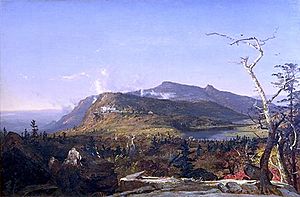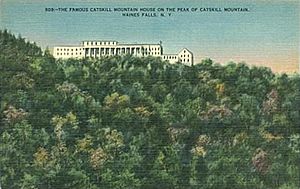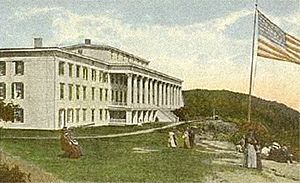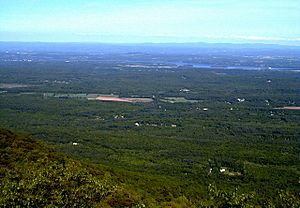Catskill Mountain House facts for kids
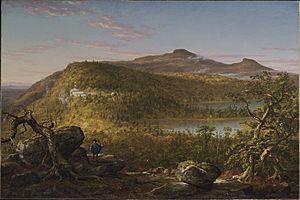
The Catskill Mountain House was a super famous hotel that opened way back in 1824. It was located in the beautiful Catskill Mountains in New York, high up and looking over the amazing Hudson River Valley. This grand hotel was near a town called Palenville, New York.
From the 1850s until around 1900, the Mountain House was a very popular spot. Three U.S. presidents — U.S. Grant, Chester A. Arthur, and Theodore Roosevelt — even stayed there! Many important and wealthy people of that time also loved to visit.
Contents
The Catskill Mountain House: A Grand Hotel
Building a Dream Hotel
The spot where the Mountain House was built was called "Pine Orchard." It was already famous for its incredible views. You could see far up and down the Hudson Valley and even further east. Famous writers like John Bartram and James Fenimore Cooper had written about this special place.
Artists and writers had discovered the beauty of the Catskills even before the hotel was built. After it opened, the Mountain House and its surroundings became a favorite subject for Washington Irving. It was also loved by artists from the new Hudson River School, especially Thomas Cole. James Fenimore Cooper even told people in Europe, "If you want to see the sights of America, go to see Niagara Falls, Lake George and the Catskill Mountain House."
The hotel was built in 1823 by a group of business people from nearby Catskill. It opened in 1824. It sat on a high flat area with amazing views of the Hudson Valley on one side. On the other side, there were two lakes that provided water and fun activities for guests.
In 1839, Charles L. Beach took over the hotel. His father ran a stagecoach service that brought guests from the town of Catskill to the Mountain House. Charles Beach later bought the hotel. He rebuilt it, changing its original Federal style to a grander neo-classical structure.
The "Fried Chicken War" and Rival Hotels
One summer day in 1880, a rich businessman from Philadelphia named George Harding was staying at the Mountain House. He asked for fried chicken for his daughter, Emily, because she couldn't eat red meat. The hotel's owner, Charles Beach, refused, even though Harding was a loyal guest.
Beach jokingly suggested that Harding should build his own hotel. Harding took him seriously! He checked out that day and started planning his own hotel. It would be on a nearby mountain, even bigger than Beach's hotel. He kept his promise and opened the Kaaterskill Hotel the next year. This was the first real competition for the Mountain House.
The competition between the two hotels became known as the "Fried Chicken War." It actually helped both hotels, as guests often walked between them for lunch or to visit.
Getting to the Mountain House was a challenge. It was a 1,600-foot (487.6 m) climb from the valley. This meant a five-hour ride by stagecoach! As other hotels that were easier to reach started to appear, the Mountain House built a special cable-operated train. This was called the Otis Elevating Railway. It brought guests directly from the Hudson River up to the hotel. However, the railway was very expensive to run. It was eventually sold for parts in 1918 during World War I.
The Hotel's Decline and End
Charles Beach used to say that the Mountain House was on the highest peaks in the Catskills. But in the 1880s, a Princeton University geologist named Arnold Henry Guyot surveyed the area. He found that the highest peak was actually Slide Mountain, many miles away. It was not Kaaterskill High Peak, which was visible from the hotel.
Beach had also claimed the hotel was at 3,000 feet (914.4 m) above sea level, but it was actually 750 feet (228.6 m) lower. He and his rivals tried to say Guyot was wrong. But by 1886, other surveyors confirmed Guyot's findings. The North-South Lake area was no longer considered the highest part of the Catskills.
Both Charles Beach and George Harding died in 1902. Other hotels became more popular, and the Adirondacks became the new fashionable place for wealthy people. The Mountain House kept operating until World War II began, with 1941 being its last season.
In 1962, the State of New York bought the property. Some people wanted to save the historic hotel. However, the state's Conservation Department decided to burn it down. This happened on January 25, 1963. They did this because of new rules about keeping the Forest Preserve wild, meaning no buildings.
What Remains Today
Today, the state runs a large public campground called North-South Lake near the old hotel site. You can easily walk to the Mountain House site from the campground along the popular Escarpment Trail.
All that is left of what was once America's most fashionable resort are the old gateposts. But the amazing, sweeping views from the cleared site are still there for everyone to enjoy.
See also



